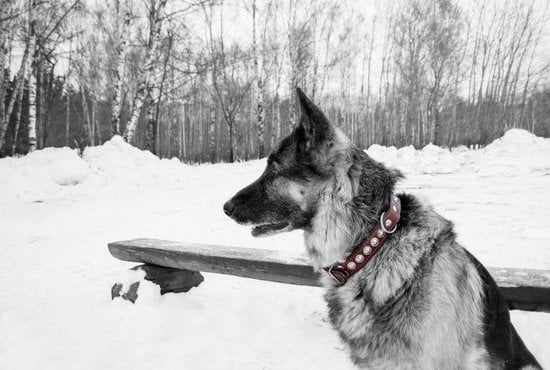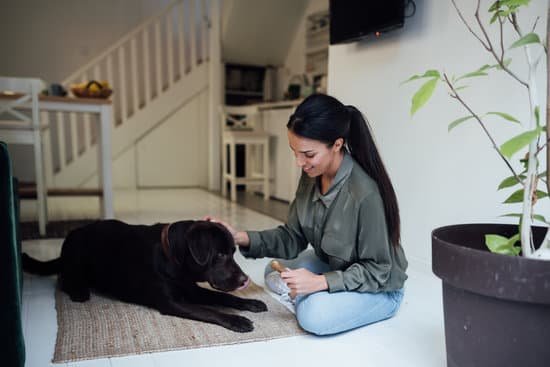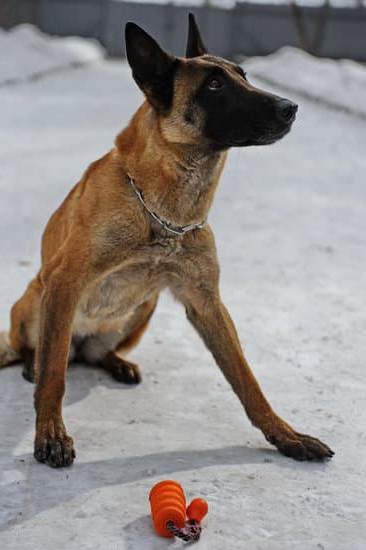Introduction
Separation anxiety is a condition experienced by some dogs when they are left alone. This can lead to disruptive behaviors such as barking, whining, chewing on furniture and objects, destructive behavior, and even inappropriate elimination. It happens because the dog has a fear of being apart from their owners – something that can have adverse effects on their health, emotions, learning abilities and overall wellbeing.
When it comes to treating separation anxiety in your dog, one of the most effective methods is crate training. Crate training helps create both physical and psychological boundaries for dogs that cannot bear to be away from their owners. Using crates for separation anxiety management teaches your pup to associate the feeling of being closed off from its owner with security, comfort and safety rather than suffering through a stressful experience.
Here’s how you can begin to crate train your pup if it has separation anxiety:
1. Establish a calm environment – Before beginning any kind of training with your dog make sure to remove potential sources of stress or distraction like loud music or visitors throughout the house. Make sure all family members understand that the surroundings should be quiet while the pup is in its crate during these training sessions.
2. Introduce the Crate Area – Make sure to lay down bedding inside the crate so that your pup becomes familiar with its space and associates it with a comforting environment where he or she can go when feeling overwhelmed or stressed out. In addition, provide plenty of chew toys and/or treats when inside so that they are encouraged to stay instead of feeling locked up and restless.
3. Start With Short Sessions- Begin by establishing short periods (5-10 minutes) in which you put the dog inside for him or her to get accustomed to it over time; gradually increase these sessions until eventually he or she will be able to stay in for longer amounts of time (30 minutes). Remember not only reward positive behaviors but also take note of problems like excessive barking or escape attempts as well. If your pup appears too anxious during this process try decreasing these intervals until he or she calms down again before continuing any further .
4 . Create Positive Associations – As soon as your pup enters his crating area give him lots of verbal praise along with occasional treats; try setting yourself up next to his space so that even when you are outside he still feels close enough; whenever you leave actually come back and check on him regularly (every 10 minutes approximately) so that he gets used to shorter sessions and begins looking forward each time you return back home .
By following these basic principles and remaining consistent during this process – separate anxiety can be handled effectively within several weeks’ time frame!
Diagnosing & Identifying Signs of Separation Anxiety
If you suspect your dog has separation anxiety, it’s important to identify the signs. These can include scratching or biting at doors or windows when you’re getting ready to leave, excessive barking and whining when they’re left alone, destructiveness in your absence, such as chewing furniture, soiling the house, depression or listlessness when you’re gone. If your pooch exhibits any of these symptoms when you are about to leave for an extended period of time, separation anxiety may be the cause. To confirm that this is indeed the case and not just the result of boredom due to lack of attention or exercise, consult a qualified veterinarian and animal behaviorist. They will help identify an appropriate course of action by creating a tailored plan specifically for your dog.
Once it has been identified that your pooch has separation anxiety, crate training is an effective form of treatment. The idea behind crate training is to make the space associated with its crate a source of comfort and familiarity instead of anxiousness and fear. Start slowly by introducing its crate in positive ways – through feeding sessions and playtime with interactive toys inside the crate – until it begins naturally wanting to retreat there for calm moments away from commotion or stressors. Make sure that these moments last for increasing lengths of time so that your pup learns how to stay emotionally regulated on their own in their den-like atmosphere until its comforting presence fades over time creating a more independent canine companion equipped with an ability to handle triggers associated with being alone without relying solely on its humans for security.
Effective Solutions to Reduce Symptoms of Separation Anxiety
Crate training your dog with separation anxiety is a great way to reduce and manage symptoms. Crate training can provide a secure environment that helps reduce stress in anxious and scared dogs. By following these steps, you will be on your way to successful crate training:
1. Start small. Begin by closing the crate door and leaving the room for a few seconds at a time, coming back before your dog starts to bark or whine. Gradually increase the time spent away from them until they are comfortable staying in their crate for an hour or two at a time.
2. Utilize positive reinforcement. Every time your pup successfully remains in their crate for the allotted amount of time reward them with verbal praise, petting, and treats if applicable. This encourages them to stay calm and comfortable in their crate instead of feeling overwhelmed and uneasy during times of separation anxiety.
3. Keep it natural. Instead of buying crates specifically used for humans’ behavior modification purposes, observe what makes your dog feel comfortable naturally due to being able to sense certain materials better than us; sheets of fabric vs plastic box-like structures might make all the difference! Doing so will help create familiarity when they must stay in their confinement but also give them an outlet to retreat back into when separated from you or other pets in the house as well!
4 Foster independence in other areas as well! Healthy independence comes through providing more moments where our dogs can receive stimulation without us present such as providing toys that can dispense kibble slowly throughout the day helping keep him occupied without needing too much supervision or comfort from us meaning he gets accustomed quickly to his new home & family routine resulting in less stress throughout separations however long or short!
Practical Guidelines for Beginning Crate Training
Crate training a dog with separation anxiety can seem like an intimidating task, but it is a helpful tool to manage the issue. Crate training allows your pet to have their own boundaries and provide them with a safe and secure environment. Here are some practical guidelines for beginning crate training:
1. Begin by introducing your pup to the crate in positive ways such as offering treats, favorite toys, and verbal praise when they enter.
2. Feed your dog near or inside the crate at meal times to create a positive association.
3. Start by placing your pup in the crate for short intervals (around 10-15 minutes). Increase the time gradually over successive days until you reach one hour of containment; continue lengthening the duration as tolerated by your dog until you can leave them alone for several hours if necessary.
4. Place blankets and bedding in the crate that smell like home to help give them comfort and security when separated from you.
5. Leave calming music, white noise machines or running fans when you have left the house so that they feel calm while they’re alone.
6. Keep an eye on their verbal cues indicating discomfort — such as barking, whining or other signs of distress — as these serve as warning signals that additional intervention is needed right away due to their emotional sensitivity concerning being apart from their guardians/families.
7 Do not force them into crates if they experience anxiety surrounding it, rather slowly introduce them over time by giving consistent positive emotions tied with it – gradually working towards longer periods of time with no fear or stress associated within intimate settings like this one!
Proper Timing & Training Practices When Crate Training
When it comes to crate training a dog with separation anxiety, starting the process at the right time is important. Before introducing your dog to the crate for any extended period of time, make sure your pup is both mentally and physically prepared. Begin by introducing your pooch to the crate slowly by familiarizing them with it first. Keep the crate in a room so that you can keep an eye on your pup while they explore. Allow them to take their time as they get comfortable sniffing around and “denning” it together with treats and toys if needed. Make sure you reward them every few moments, which helps your pup start forming positive associations with the crate.
From there you can start gradually lengthening their time in their den and eventually closing the door during calm behaviors like sitting or resting. As this behavior becomes comfortable for them, start increasing their alone times in measured increments — no more than 30 minutes — until they are able to stay crated without anxiety while you’re away from home. Building up from shorter periods of being crated allows dogs confidence and helps manage any distress associated with being left alone so that these anxieties don’t become worse over time. When ending each session, always leave something for them to occupy themselves with in order to help reassure them that you will return soon enough. You may also choose to provide interactive puzzle toys or other sources of stimulation when leaving your pup alone for longer periods of times. As long as proper timing and training practices are used, most dogs can transition into enjoyable den-time nearly painlessly!
Appropriate Material to Place in the Crate
When crate training a dog with separation anxiety, it is important to make sure that the inside of the crate is comfortable and inviting. To do this, place some comfort items inside the crate such as blankets or towels, a dog bed with some cushioning, toys or treats, and possibly a piece of clothing with your scent on it (consider washing an old t-shirt in order to introduce your scent to them). Make sure not to clutter the crate as this can cause more stress for your pup. Also ensure that there are no sharp objects or dangling cords that could harm them while they are inside of the crate. Furthermore, you may want to provide a water bowl that fits comfortably inside of the crate depending on how long you will be away from home. This will allow them to stay hydrated and cool if necessary during their stay in the cate.
Steps to Take When Introducing the Crate Outdoors
1. Start by taking your dog outside with the crate, without closing the door. Talk to your pup in an excited manner and offer them some treats while they are still inside the crate. This will help create a positive association with it.
2. Once your pup has entered the crate willingly, you can move it to a suitable spot outside that’s safe and comfortable for them. Gradually increase their time in the crate as you stay nearby, talking to them and offering them treats every so often.
3. Place some of their favorite toys inside the crate for further stimulation for your pup’s mental wellbeing and satisfaction during their time alone outdoors in it. Toys can also provide reassurance that playtime will eventually be available again upon exiting the crate when you return later on.
4. Slowly progress from short sessions spent just outside with your pup in the crate to gradually extending those times over several days or weeks depending on their comfort level at each stage of training; however do not push too quickly or else drastic setbacks may occur within this very sensitive process as a result.
5. Once your pup is comfortable spending alone-time in their outdoor-crate and that anxiety levels have significantly reduced, you can begin transitioning surfaces that are inside versus those outdoors elsewhere; such as introducing new products like Artificial Grass or similar materials indoors! These products provide cleanliness, ease of maintenance and convenience that are often attractive factors worth considering when beginning this journey with separation anxiety crating efforts (evetus).
Strategies for Long-term Anxiety-free Separation
Crate training your dog when it is suffering from separation anxiety can be a challenge. However, it is essential to help develop its trust and security by providing a safe area that the dog can go to when feeling anxious. The following are some strategies for crate training your dog with separation anxiety:
1. Introduce the Crate Slowly: Start by setting up the crate in an area of your home where your pup feels comfortable and safe. Leave the door open and place toys, treats, or a piece of clothing that smells like you inside. Then, slowly introduce the crate, allowing your pup to explore at his own pace. If they seem distressed or fearful, try using positive reinforcement and encouraging words.
2. Training Exercises: Practice short exercises in which you entice your pup into their crate with either verbal praise, treats or food rewards upon entering and staying in the crate for short periods of time. This is important for establishing a positive association between the pup entering its safe space on command. For example, you could use phrases such as “Go to your bed” or “Time for bed” when placing the pup inside their create each time you repeat this exercise session.
3. Make It Fun: Make living in the crate fun and enticing by adding interactive toys (such as a Kong filled with treats), music, or including routine tasks such as mealtime inside of it so that there is something pleasant associated with being in their space while they are separated from you- one bonus small gesture could make all the difference!
4. Greeter Roles: Finally if possible have multiple people in household take on greeters roles- individuals who will be tasked with visiting and pets puppies whenever they exhibit signs of stress during times of separation anxiety , this act not only helps reinforce rules concerning personal space but also makes puppy starts associating those people with feeling good instead of fearing them during times of distress
Examples of Positive Reinforcement Training Practices
Crate training dogs with separation anxiety is an effective way to help them manage their fear of being left alone. It can also be used to help boundaries and structure in their day-to-day lives. The following are some positive reinforcement training practices to use when crate training:
• Give your dog a reward or treat when they enter their crate on command. This will encourage them to view the crate positively and associate it with good things.
• Provide plenty of praise and petting whenever they exhibit quiet behavior in the crate, such as curling up or lying down.
• Don’t close the door right away – allow your dog time to become comfortable with being in the space before you deploy any stay commands.
• When it’s time for them to stay, give verbal commands like “stay” or “wait” and gradually increase the amount of time they need to stay until it becomes familiar routine.
• At first, try leaving for very brief periods, like around 5 minutes at a time, then extending this as your pup learns that going into their crate does not mean you disappear forever.
• When you get back from a period outside the home, return calmly and reassuringly so that your pup knows you haven’t abandoned them completely! Show that you are pleased by providing plenty of love, pets, and treats.
Tips & Information for Owners for Comfort and Wellbeing of their Dog
Crate training a dog with separation anxiety requires patience and understanding from the owner. It can be difficult to watch our furry friends go through high levels of stress, but it is important to provide them with a safe and comfortable space.
The key to successful crate training is providing an environment suited to your dog’s needs. Make sure it’s around waist-high and large enough that they can stand up, turn around, and lay down comfortably. Put something soft in it, like a blanket or one of your old t-shirts so they have something familiar and cozy.
It’s a good idea to start off progress slowly by putting treats inside the crate. This will offer positive reinforcement for your pup every time he or she enters the space, rather than making them feel anxious or nervous about being locked inside a confined area. Offer treats upon entering the kennel, when taking breaks during your training sessions and at bedtime for added comfort throughout the entire process.
Once you’ve built trust between you two surrounding this new space, steadily increase times spent in the crate each day leading up to overnight if needed. If your pup does demonstrate anxiety during this period, use positive reinforcement among calming music or aromatherapy as distractions/ai before, during and after these periods in their kennel .
Crate training can be an effective way for dogs with separation anxiety to learn how to cope better with being separated from their owners while feeling safe inside their newfound home away from home – all while feeling confident they’re going to have a great time doing so!

Welcome to the blog! I am a professional dog trainer and have been working with dogs for many years. In this blog, I will be discussing various topics related to dog training, including tips, tricks, and advice. I hope you find this information helpful and informative. Thanks for reading!





